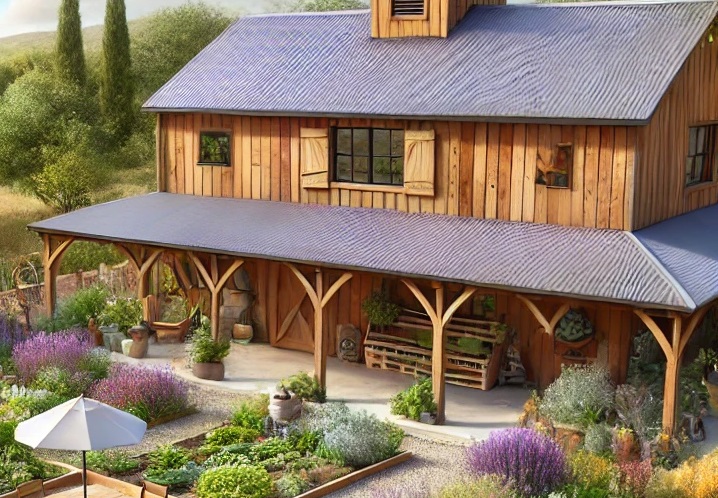Designing the perfect wall assembly for a barndominium is a balancing act between energy efficiency, durability, comfort, and cost. Unlike conventional homes, barndominiums often begin with a post-frame or steel-frame shell, which introduces unique challenges—thermal bridging, condensation risks, and proper layering of insulation and barriers. Getting the wall assembly right can make the difference between a structure that feels drafty and damp versus one that’s airtight, comfortable, and low-cost to operate.
In this article, we’ll break down the anatomy of the perfect barndominium wall assembly—covering R-value, air barriers, and vapor retarders—and show how they work together to deliver superior performance.
Why Wall Assemblies Matter in Barndominiums
Many people fall in love with the wide-open spaces and affordability of barndominiums, but forget that energy efficiency and comfort don’t happen automatically. The large expanses of metal siding common in barndos act as thermal conductors, creating heat loss in winter and heat gain in summer.
Without careful planning, barndominiums can struggle with:
- High energy bills due to poor insulation strategies
- Drafts and uneven heating/cooling
- Moisture trapped within walls leading to mold or rust
- Shortened lifespan of structural components
That’s where the right wall assembly design comes in. It’s not just about insulation—it’s about creating a system that controls heat, air, and moisture movement.
Breaking Down the Key Components
- R-Value: The Insulation Factor
The R-value is the measurement of thermal resistance—the higher the R-value, the better the wall resists heat flow. But not all R-values are equal when installed in real-world conditions.
- Fiberglass batts may claim R-19, but if poorly installed around steel studs, performance drops drastically due to thermal bridging.
- Closed-cell spray foam offers R-6 to R-7 per inch and doubles as an air barrier, but it comes with higher upfront costs.
- Rigid foam boards (polyiso, EPS, XPS) can break thermal bridges when applied continuously on the exterior of framing.
- Mineral wool provides excellent fire resistance and maintains R-value even when wet, though it requires proper air sealing.
For a barndominium, insulation must consider both the nominal R-value (what’s on the packaging) and the effective R-value (what it delivers once installed in a steel or post-frame assembly).
- Air Barriers: Stopping Uncontrolled Airflow
Heat loss doesn’t just happen through conduction—it also happens via air leakage. Even small cracks in the wall assembly can add up to significant energy loss.
An air barrier is a continuous layer within the wall assembly that prevents uncontrolled airflow while still allowing controlled ventilation. Common solutions include:
- Spray foam insulation (acts as both insulation and air barrier when applied correctly).
- House wrap (Tyvek, Typar) placed behind siding as part of the weather-resistive barrier system.
- Taped sheathing panels (like ZIP System) that combine structural sheathing with an integrated air barrier.
For barndominiums with large wall spans and many penetrations (doors, windows, mechanical chases), an airtight layer is non-negotiable. Air leakage not only wastes energy but also carries moisture into the wall cavity, where it can condense on cold steel or wood.
- Vapor Retarders: Controlling Moisture Diffusion
While air barriers stop bulk airflow, vapor retarders slow down the movement of water vapor by diffusion. In steel-frame barndominiums, vapor control is crucial—otherwise condensation can form on cold steel surfaces and lead to corrosion or rot.
Vapor retarders are rated by permeance (perms):
- Class I (impermeable, ≤ 0.1 perm): Polyethylene sheeting, foil-faced insulation.
- Class II (semi-impermeable, 0.1 – 1 perm): Kraft-faced fiberglass batts.
- Class III (semi-permeable, 1 – 10 perms): Latex paint, some house wraps.
The correct placement of vapor retarders depends on climate zone:
- Cold climates: Vapor retarder goes on the interior (warm side) of the wall.
- Hot-humid climates: Vapor retarder goes on the exterior to keep outside humidity from entering.
- Mixed climates: A “smart vapor retarder” (such as CertainTeed MemBrain) adjusts permeability seasonally, reducing risk of trapped moisture.
Anatomy of the “Perfect” Barndominium Wall Assembly
While there’s no single one-size-fits-all wall assembly, the ideal system for most barndominiums will address insulation, air sealing, and vapor management together.
Here’s a high-performance example for a steel-frame barndominium in a mixed climate:
- Exterior metal siding – Durable, low-maintenance cladding.
- Ventilated rainscreen gap – Allows drainage and drying behind siding.
- Weather-resistant barrier (WRB) – House wrap or fluid-applied WRB, taped and sealed.
- Continuous exterior rigid foam insulation – 1–2 inches of polyiso or XPS to break thermal bridging.
- Steel framing with cavity insulation – Closed-cell spray foam (2 inches) or mineral wool batts.
- Interior smart vapor retarder – Helps control seasonal vapor movement.
- Drywall with airtight detailing – Interior finish layer, taped and sealed at penetrations.
This approach creates:
- High effective R-value (R-25 to R-30 range depending on thickness).
- Continuous air barrier for reduced leakage.
- Vapor-smart system that adapts to humidity conditions.
- Thermal bridge mitigation at framing members.
Common Mistakes in Barndominium Wall Design
Even with good intentions, builders often make errors that compromise performance:
- Skipping the air barrier – Relying only on insulation without sealing gaps leads to drafts and condensation.
- Incorrect vapor retarder placement – Installing polyethylene on both sides of the wall can trap moisture.
- Ignoring thermal bridging – Metal studs or posts conduct heat, lowering the real-world R-value.
- Overstuffing insulation – Compressing fiberglass batts reduces their R-value.
- Poor flashing and sealing – Around windows, doors, and penetrations, leading to hidden leaks.
Climate-Specific Considerations
The perfect wall assembly is not universal—it must be tuned to the local climate zone:
- Cold climates (Minnesota, Montana): High R-values (R-30+), continuous insulation, and interior vapor control are critical.
- Hot-humid climates (Texas Gulf Coast, Florida): Focus on exterior vapor retarders, reflective insulation, and robust WRBs.
- Mixed climates (Midwest, Mid-Atlantic): Smart vapor retarders and hybrid insulation systems prevent seasonal issues.
- Dry climates (Arizona, Nevada): Air sealing and UV-resistant exterior layers matter more than vapor control.
Balancing Cost and Performance
While spray foam and continuous exterior insulation create an excellent wall assembly, not every homeowner has the budget. Fortunately, there are cost-conscious alternatives:
- Combine fiberglass or mineral wool batts with a taped sheathing air barrier.
- Add even 1 inch of exterior rigid foam to reduce thermal bridging.
- Use a Class II vapor retarder instead of a full smart membrane if budget is tight.
Even incremental improvements can deliver better comfort and long-term savings.
Final Thoughts: Building a Barndominium That Lasts
The “perfect” barndominium wall assembly isn’t just about hitting code minimums—it’s about creating a durable, efficient, and healthy home. By carefully analyzing R-value, air barriers, and vapor retarders, you can avoid common pitfalls and design walls that work with your climate, not against it.
Think of it as a three-legged stool:
- Insulation (R-value) keeps heat where you want it.
- Air barriers keep drafts and moisture-laden air out.
- Vapor retarders manage hidden condensation risks.
When all three are in balance, your barndominium walls will deliver comfort and performance for decades.

